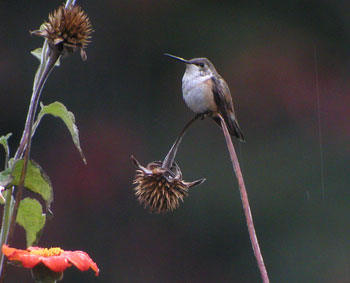 Rufous Hummingbird, Selasphorus
rufus, immature female, Lenoir Preserve, Yonkers, Westchester Co., NY, 4 November
2002.
Rufous Hummingbird, Selasphorus
rufus, immature female, Lenoir Preserve, Yonkers, Westchester Co., NY, 4 November
2002.
All pictures were taken by my son Jay (I was on video
detail, which doesn't add much to the story) and are © Kevin and Jay
McGowan. They were taken with an Olympus D-40 digital camera
through my Swarovski HD-80 spotting scope.
Click on the images for a larger version.
Hosted by the 
First seen on 29 October 2002, and reported by Mike Bochnik on 30
October, at the Lenoir Nature Preserve
in Westchester Co., NY. This is exactly the same place that an immature male Rufous
Hummingbird showed up last year (see our web page for
that bird).
Although it was suspected of being a Rufous Hummingbird, some things
did not quite fit with that identification, and suggested Broad-tailed Hummingbird:
limited and rather pale rufous flanks, limited rufous in tail, lack of spotting in center
of throat. After close scrutiny (as explained below), and not with 100% certainty, I
now think it was an immature female Rufous Hummingbird. (Thanks go to all the folks
who sent me comments on the species identification.)
Jay and I visited Lenoir on the rainy morning of 4 November 2002,
and with the kind assistance of Tom Fiore (and his umbrella), we managed to find the bird
and get a few decent pictures (despite the bad light).
Description from observations (i.e., what we noticed in the field):
- A female-plumaged hummingbird with a green back, mostly whitish chest
and underparts, and light rufous flanks.
- A bit of rufous was visible above the wing of the perched bird.
- The rump appeared green, the same color as the back.
- The tail was dark with broad white tips to the outer 3 feathers. It
showed some rufous on the outer feathers when the tail was spread, but just how much was
difficult to determine (thank goodness for pictures!).
- The tail was rather long, and extended beyond the wingtips when the
bird was perched.
- The white tips to the tail looked broad and the tail feathers were
noticeably rounded. It was obvious from views in the scope that the outer tail
feather was pretty broad, suggesting that it was not an Allen's Hummingbird.
- The bill was straight, or only very slightly down-curved, and medium
to long.
- The eye was dark with a small white spot directly posterior to it.
The lores were dark.
- The throat was white with only very small dusky spots present on any
of the feathers. Jay noted that all of the throat feathers appeared white, but in fact
they had tiny dark spots on them. As he put it, it was like the feathers were
outlined with the adult pattern, kind of like a paint-by-numbers picture.
- Quite noticeable to me was a dusky or medium-gray patch of feathers
directly below the eye, on the cheek. It was irregularly shaped and extended down the
cheek where the color was broken up into dull spots.
- The bird moved around quite a bit, foraging only infrequently, and
then usually just out of sight. It spent much time perched in view, looking quickly
and repeatedly from side to side. It did stretch some, conveniently fanning the
tail. We also observed it scratching (ridiculously over the top of the wing), bill
wiping, sticking out its tongue, and sticking its head up and flapping its wings.
Additional details from the photographs:
- A thin, dirty-white line extended from the dark lores posteriorly to
the white spot behind the eye.
- The rufous on the sides above the wing was apparently part of the
flanks and did not reach the rump.
- The rump was entirely green.
- The back was iridescent blue-green.
- The outermost tail feather was indeed rather broad, but not as broad
as the next two in.
- The head was duller brownish than the back.
- The rufous on the tail feathers extended across both vanes at the
base of the three outermost tail feathers, but was restricted on the fourth one in
(rectrix 2 or r2), where it appears to be only on the inner vane (the outer vane was
green). On no feather did the rufous extend out beyond the midpoint of the feather.
Beyond the rufous the feathers were broadly black, with large white tips.
- Rectrix 2 had a very small white tip.
- The central tail feather (r1) was completely dark green throughout,
with a darker tip, blackish at the edges of the feather tip, and was slightly longer than
r2.
- Rectrix 4 was longer than r5, but markedly shorter than r3, with a
nearly even gradation in length from r5 -> r4 -> r3.
- I do NOT see a notch on the inner vane of r2 that would (nearly)
diagnostic of Rufous Hummingbird.
- The white throat contained a single dark feather in the upper right
part, and a few along the lower gorget rim area. The entire feather was not dark,
but rather contained a dark spot in its middle. The middle of most (all?) throat
feathers contained a single small dark area, smaller than that of the other feathers.
These dark spots gave the throat a faint speckling. Unfortunately, the dark
conditions prevented us getting a completely clear picture of this character.
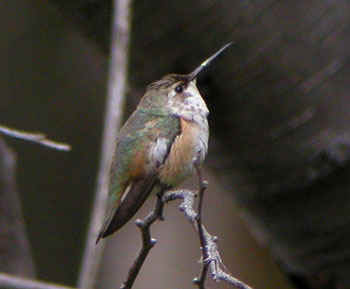
|
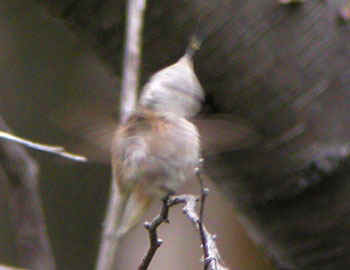
|
Notice the pineapple sage pollen on the top of the bill.
|
The bird stretched and buzzed sometimes before taking flight.
|
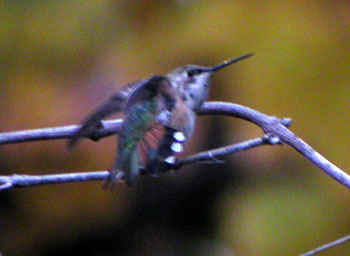
|
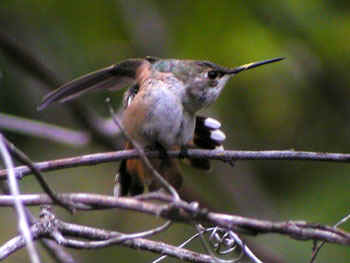
|
Note the extent of the rufous on the outermost tail
feathers. It is restricted to the basal half of the three outermost (r3-5), and
appears to be only on the inner vane of r2. Note that the central tail feather (r1) is the
same length of slightly longer than r2, and that r4 is markedly shorter than r3.
|
R2, just below the branch and with the tiny white
tip, does not appear to be notched on the downside to me. Does it to you?
|
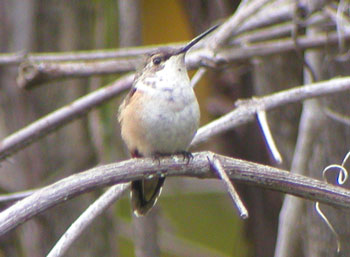
|
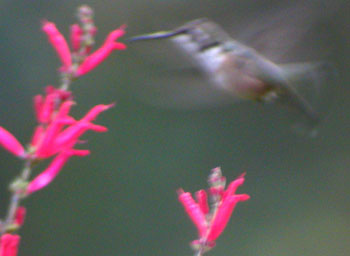
|
This view shows the whitish throat and chest, and the
pale rufous undertail coverts.
|
This is the only flying shot that Jay got. I
got no video either.
|
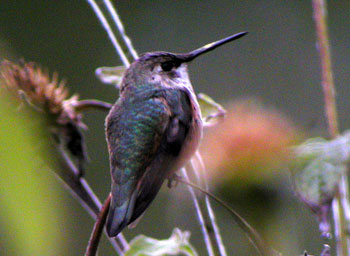
|
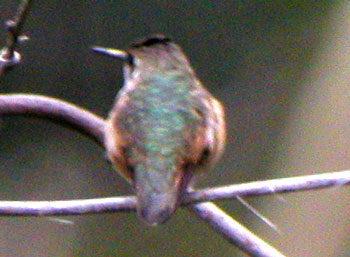
|
This shot shows the iridescent blue-green back, the
lack of rufous in the rump, and that the central tail feather is longest.
|
Unfortunately blurry, this shot is our best one of
the rump.
|
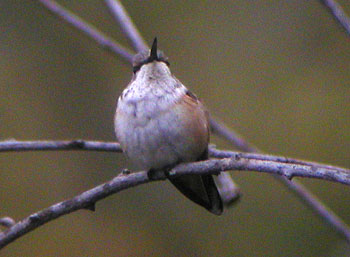
|
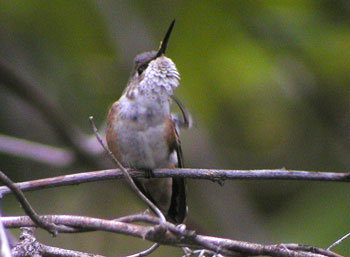
|
This full throat-on view shows the single largish
dark spot on the upper right region of the throat, the several larger spots along the
gorget edge, and hints at the small speckles on the other throat feathers.
|
This shot of it scratching (over the wing!) shows off
the small spots on the throat feathers. It appears that the spots are central to
each feather, perhaps being pigment in the rachis.
|
| These enlargements are meant to show the fine spotting
on the throat feathers. The larger spots in the lower feathers are obvious enough,
but look for the finer spotting on the upper feathers too. |
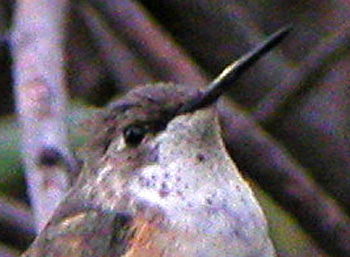 |
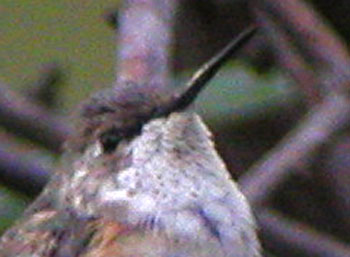 |
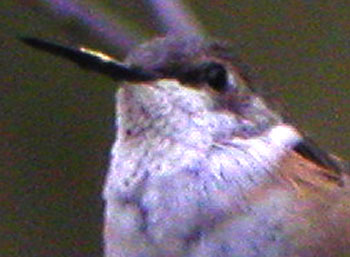 |
Comparing the tail pattern to that shown for Broad-tailed
Hummingbird in Steve N. G. Howell's Hummingbirds of North America: A Photographic
Guide (2001. Academic Press) suggests that this is a Rufous Hummingbird.
Specifically, the central rectrix (r1) should be shorter than r2 (not slightly
longer as it appears on the Lenoir bird), and r3 and r4 should not be dramatically
different in length. In the Lenoir bird r4 seems about as different from r3 as it is
from r5 (the outermost feather), typical of Rufous. Here are a couple of comparison
photos to illustrate the tail patterns.
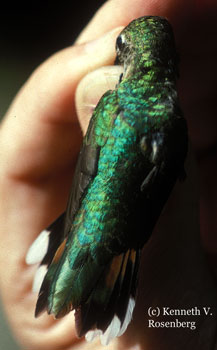
|
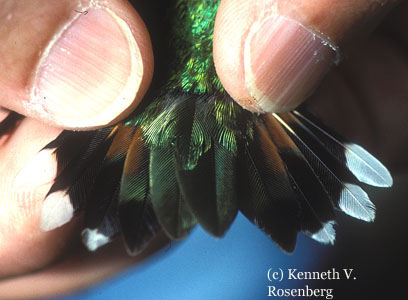
|
| These pictures are of a Broad-tailed
Hummingbird taken in Louisiana in December 1989 by Kenneth V. Rosenberg. Notice
the central tail feathers a noticeably shorter than r2. Notice also that the inner two
feathers that have white tips (r3 and r4) are roughly the same length (actually, r4 looks
slightly longer), but longer than the outermost (r5). They do not give a stair-stepped
effect. |
 |
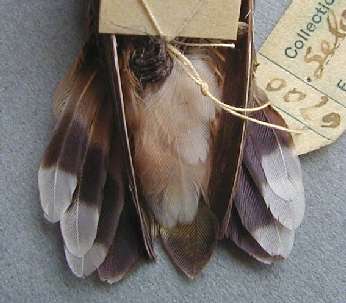 |
Here are two views of a Rufous
Hummingbird specimen in the Cornell University Museum of Vertebrates (CU5404;
immature male; collected in New Mexico, 10 August 1901). Notice the better fit to
the Lenoir hummingbird: the central rectrix is just about the same length as r2, and
the white-tipped outer feathers are rather evenly stair-stepped.
|
Return to the Bad Photos page.
Return to Kevin McGowan's home page.
Go to the Crow Page.
Go to the Cornell Lab of
Ornithology's home page
Revised: April 08, 2005.
 Rufous Hummingbird, Selasphorus
rufus, immature female, Lenoir Preserve, Yonkers, Westchester Co., NY, 4 November
2002.
Rufous Hummingbird, Selasphorus
rufus, immature female, Lenoir Preserve, Yonkers, Westchester Co., NY, 4 November
2002. Rufous Hummingbird, Selasphorus
rufus, immature female, Lenoir Preserve, Yonkers, Westchester Co., NY, 4 November
2002.
Rufous Hummingbird, Selasphorus
rufus, immature female, Lenoir Preserve, Yonkers, Westchester Co., NY, 4 November
2002.



